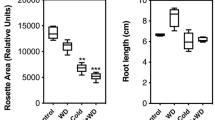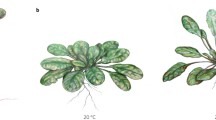Abstract
High-temperature (HT) stress is an environmental factor that limits growth and productivity in various ways, depending upon organ type and the temperature and duration at which plants are challenged by HT-induced challenges. Thus, understanding how plants respond to heat is crucial if researchers are to develop crops that can withstand a rise in average temperatures due to climate change. In particular, the impacts of HT on reproductive organs are directly linked to crop productivity and/or food security, two key issues in agriculture. We used the Arabidopsis thaliana model system to examine how an elevated daytime temperature might influence the development of sexual organs. After 2 days of exposure to 35/22 °C (day/night), fertility gradually decreased for 3-week-old plants. After 5 days of exposure, fertility was dramatically reduced and plants displayed abnormal stamens, i.e., short filaments, poor production of viable pollen grains, and defective anther dehiscence. In contrast, female organs remained functional. Furthermore, the developing pollen grains from stressed plants underwent aberrant cytokinesis that generated a high proportion of unreduced, aneuploid, and diploid pollen. The formation of enlarged grains may have been due to polyploidization, which contributed to temperature-induced speciation and evolution. Our findings will aid in the molecular genetic dissection of HT-related damage in male reproductive organs, which are the most vulnerable to such stress.





Similar content being viewed by others
References
Ahmed FA, Hall AE, Demason DA (1992) Heat injury during floral development in cowpea (Vigna unguiculata, Fabaceae). Amer J Bot 79:784–791
Alonso-Ramírez A, Rodríguez D, Reyes D, Jiménez JA, Nicolás G, López-Climent M, Gómez-Cadenas A, Nicolás C (2009) Evidence for a role of gibberellins in salicylic acid-modulated early plant responses to abiotic stress in Arabidopsis seeds. Plant Physiol 150:1335–1344. https://doi.org/10.1104/pp.109.139352
Bac-Molenaar JA, Fradin EF, Becker FF, Rienstra JA, van der Schoot J, Vreugdenhil D, Keurentjes JJ (2015) Genome-wide association mapping of fertility reduction upon heat stress reveals developmental stage-specific QTLs in Arabidopsis thaliana. Plant Cell 27:1857–1874
Bita CE, Gerats T (2013) Plant tolerance to high temperature in a changing environment: scientific fundamentals and production of heat stress-tolerant crops. Front Plant Sci 4:273. https://doi.org/10.3389/fpls.2013.00273
Cecchetti V, Altamura MM, Falasca G, Costantino P, Cardarelli M (2008) Auxin regulates Arabidopsis anther dehiscence, pollen maturation, and filament elongation. Plant Cell 20:1760–1774. https://doi.org/10.1105/tpc.107.057570
Cecchetti V, Brunetti P, Napoli N et al (2015) ABCB1 and ABCB19 auxin transporters have synergistic effects on early and late Arabidopsis anther development. J Integr Plant Biol 57:1089–1098
Cecchetti V, Celebrin D, Napoli N, Ghelli R, Brunetti P, Costantino P, Cardarelli M (2017) An auxin maximum in the middle layer controls stamen development and pollen maturation in Arabidopsis. New Phytol 213:1194–1207. https://doi.org/10.1111/nph.14207
Cheng Y, Dai X, Zhao Y (2006) Auxin biosynthesis by the YUCCA flavin monooxygenases controls the formation of floral organs and vascular tissues in Arabidopsis. Genes Dev 20:1790–1799
de Storme N, Geelen D (2011) The Arabidopsis mutant jason produces unreduced first division restitution male gametes through a parallel/fused spindle mechanism in meiosis II. Plant Physiol 155:1403–1415
de Storme N, Geelen D (2014) The impact of environmental stress on male reproductive development in plants: biological processes and molecular mechanisms. Plant Cell Environ 37:1–18
de Storme N, Copenhaver GP, Geelen D (2012) Production of diploid male gametes in Arabidopsis by cold-induced destabilization of postmeiotic radial microtubule arrays. Plant Physiol 160:1808–1826
Divi UK, Krishna P (2009) Brassinosteroid: a biotechnological target for enhancing crop yield and stress tolerance. Nat Biotechnol 26:131–136. https://doi.org/10.1016/j.nbt.2009.07.006
Dobrá J, Černý M, Štorchová H et al (2015) The impact of heat stress targeting on the hormonal and transcriptomic response in Arabidopsis. Plant Sci 231:52–61
Endo M, Tsuchiya T, Hamada K, Kawamura S, Yano K, Ohshima M, Higashitani A, Watanabe M, Kawagishi-Kobayashi M (2009) High temperatures cause male sterility in rice plants with transcriptional alterations during pollen development. Plant Cell Physiol 50:1911–1922
Fahad S, Bajwa AA, Nazir U, Anjum SA, Farooq A, Zohaib A, Sadia S, Nasim W, Adkins S, Saud S, Ihsan MZ, Alharby H, Wu C, Wang D, Huang J (2017) Crop production under drought and heat stress: plant responses and management options. Front Plant Sci 8:1147. https://doi.org/10.3389/fpls.2017.01147
Frank G, Pressman E, Ophir R, Althan L, Shaked R, Freedman M, Shen S, Firon N (2009) Transcriptional profiling of maturing tomato (Solanum lycopersicum L.) microspores reveals the involvement of heat shock proteins, ROS scavengers, hormones, and sugars in the heat stress response. J Exp Bot 60:3891–3908
Hall AE (1992) Breeding for heat tolerance. Plant Breed Rev 10:129–168
Hedhly A, Hormaza JI, Herrero M (2008) Global warming and plant sexual reproduction. Trends Plant Sci 14:30–36
Herrero M (2003) Male and female synchrony and the regulation of mating in flowering plants. Phil Trans Roy Soc Lond Ser B-Biol Sci 358:1019–1024
Houghton JT, Ding Y, Griggs DJ, Noguer M, van der Linden PJ, Dai X, Maskell K, Johnson CA (2001) Climate change 2001: the scientific basis. Cambridge University Press, Cambridge, p 881
Jagadish SVK, Muthurajan R, Oane R, Wheeler TR, Heuer S, Bennett J, Craufurd PQ (2010) Physiological and proteomic approaches to address heat tolerance during anthesis in rice (Oryza sativa L.). J Exp Bot 61:143–156
Kakani VG, Prasad PV, Craufurd PQ, Wheeler TR (2002) Response of in vitro pollen germination and pollen tube growth of groundnut (Arachis hypogaea L.) genotypes to temperature. Plant Cell Environ 25:1651–1661
Kazan K (2015) Diverse roles of jasmonates and ethylene in abiotic stress tolerance. Trends Plant Sci 20:219–229. https://doi.org/10.1016/j.tplants.2015.02.001
Kim SY, Hong CB, Lee I (2001) Heat shock stress causes stage specific male sterility in Arabidopsis thaliana. J Plant Res 114:301–307
Larkindale J, Hall JD, Knight MR, Vierling E (2005) Heat stress phenotypes of Arabidopsis mutants implicate multiple signaling pathways in the acquisition of thermotolerance. Plant Physiol 138:882–897
Lee JY, Lee DH (2003) Use of serial analysis of gene expression technology to reveal changes in gene expression in Arabidopsis pollen undergoing cold stress. Plant Physiol 132:517–529
Li S, Zhou X, Chen L, Huang W, Yu D (2010) Functional characterization of Arabidopsis thaliana WRKY39 in heat stress. Mol Cells 29:475–483. https://doi.org/10.1007/s10059-010-0059-2
Mittler R, Finka A, Goloubinoff P (2012) How do plants feel the heat? Trends Biochem Sci 37:118–125
Morrison MJ, Stewart DW (2002) Heat stress during flowering in summer Brassica. Crop Sci 42:797–803
Oh SA, Allen T, Twell D (2010) A ticket for the live show: microtubules in male gametophyte development. Plant Signal Behav 5:614–617. https://doi.org/10.4161/psb.11505
Park SK, Howden R, Twell D (1998) The Arabidopsis thaliana gametophytic mutation gemini pollen1 disrupts microspore polarity, division asymmetry and pollen cell fate. Development 125:3789–3799
Pécrix Y, Rallo G, Folzer H, Cigna M, Gudin S, Le Bris M (2011) Polyploidization mechanisms: temperature environment can induce diploid gamete formation in Rosa sp. J Exp Bot 62:3587–3597
Peleg Z, Blumwald E (2011) Hormone balance and abiotic stress tolerance in crop plants. Curr Opin Plant Biol 14:290–295. https://doi.org/10.1016/j.pbi.2011.02.001
Peterson R, Slovin JP, Chen C (2010) A simplified method for differential staining of aborted and non-aborted pollen grains. Inter J Plant Biol 1:e13
Sakata T, Oshino T, Miura S, Tomabechi M, Tsunaga Y, Higashitani N, Miyazawa Y, Takahashi H, Watanabe M, Higashitani A (2010) Auxins reverse plant male sterility caused by high temperatures. Proc Natl Acad Sci USA 107:198569–198574
Takeoka Y, Hiroi K, Kitano H, Wada T (1991) Pistil hyperplasia in rice spikelets as affected by heat-stress. Sex Plant Reprod 4:39–43
Wijnker E, Velikkakam James G, Ding J, Becker F, Klasen JR, Rawat V, Rowan BA, de Jong DF, de Snoo CB, Zapata L, Huettel B, de Jong H, Ossowski S, Weigel D, Koornneef M, Keurentjes JJ, Schneeberger K (2013) The genomic landscape of meiotic crossovers and gene conversions in Arabidopsis thaliana. Elife 2:e01426. https://doi.org/10.7554/eLife.01426
Xia XJ, Zhou YH, Shi K, Zhou J, Foyer CH, Yu JQ (2015) Interplay between reactive oxygen species and hormones in the control of plant development and stress tolerance. J Exp Bot 66:2839–2856. https://doi.org/10.1093/jxb/erv089
Xing J, Xu Y, Tian J, Gianfagna T, Huang B (2009) Suppression of shade- or heat-induced leaf senescence in creeping bentgrass through transformation with the ipt gene for cytokinin synthesis. J Am Soc Hort Sci 134:602–609
Yamada M, Greenham K, Prigge MJ, Jensen PJ, Estelle M (2009) The transport inhibitor response 2 gene is required for auxin synthesis and diverse aspects of plant development. Plant Physiol 151:168–179
Acknowledgements
The authors thank Professor Danny Geelen from the University of Ghent, Belgium, for kindly providing seeds of tetraploid and octaploid Arabidopsis. This work was supported by the Cooperative Research Program for Agriculture Science and Technology Development (Agricultural Biotechnology Research Center; Project No. PJ01369001), Rural Development Administration, Republic of Korea.
Author information
Authors and Affiliations
Corresponding author
Ethics declarations
Conflict of interest
The authors declare that they have no conflicts of interest.
Additional information
Publisher's Note
Springer Nature remains neutral with regard to jurisdictional claims in published maps and institutional affiliations.
Rights and permissions
About this article
Cite this article
Nguyen, T.D., Jang, S., Soh, MS. et al. High daytime temperature induces male sterility with developmental defects in male reproductive organs of Arabidopsis. Plant Biotechnol Rep 13, 635–643 (2019). https://doi.org/10.1007/s11816-019-00559-8
Received:
Accepted:
Published:
Issue Date:
DOI: https://doi.org/10.1007/s11816-019-00559-8




